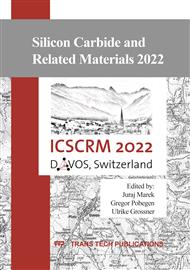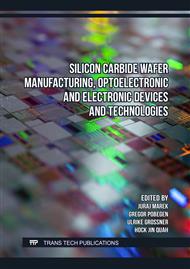[1]
X. Ma, M. Parker, and T.S. Sudarshan, Nondestructive defect delineation in SiC wafers based on an optical stress technique, Appl. Phys. Lett. 80 (2002) 3298-3300.
DOI: 10.1063/1.1469659
Google Scholar
[2]
G. Chung, I. Manning, A. Soukhojak, M. Gave and C Lee, Decoration and Density Increase of Dislocations in PVT-Grown SiC Boules with Post-Growth Thermal Processing, Materials Science Forum. 1062 (2022) 246-250.
DOI: 10.4028/p-43627c
Google Scholar
[3]
M. Odawara, K. Kamei, Y. Miyasaka, T. Yamashita, S. Takahashi, Y. Kageshima, K. Momose, H. Osawab, and T. Sato, Defects grouping and characterizations of PL-imaging methods for 4H-SiC epitaxial layers, Materials Science Forum. 778-780 (2014) 382-385.
DOI: 10.4028/www.scientific.net/msf.778-780.382
Google Scholar
[4]
H. Sako, H. Matsuhata, M. Sasaki, M. Nagaya, T. Kido, K. Kawata, T. Kato, J. Senzaki, M. Kitabatake, and H. Okumura, Micro-structural analysis of local damage introduced in subsurface regions of 4H-SiC wafers during chemo-mechanical polishing, J. Appl. Phys. 119 (2016) 135702.
DOI: 10.1063/1.4945017
Google Scholar
[5]
M. Sasaki, H. Matsuhata1, K Tamura, H Sako, K Kojima, H Yamaguchi, and M Kitabatake, Synchrotron X-ray topography analysis of local damage occurring during polishing of 4H-SiC wafers, J. Appl. Phys. 54 (2015) 091301.
DOI: 10.7567/jjap.54.091301
Google Scholar
[6]
R. Anzalone, N. Piluso, M. Salanitri, S. Lorenti, G. Arena, and S. Coffa, Hydrogen Etching Influence on 4H-SiC Homo-Epitaxial Layer for High Power Device, Mater. Sci. Forum. 897 (2016) 71-74.
DOI: 10.4028/www.scientific.net/msf.897.71
Google Scholar
[7]
Kwansei Gakuin University, Toyota Tsusho Corporation. (March 1, 2021). Kwansei Gakuin University and Toyota Tsusho Develop Innovative Process that Achieves "Zero Defects" in 6-Inch SiC Substrates - Supply of Samples to Device Manufacturers to Begin to Facilitate Early Mass Production [Press release]. https://global.kwansei.ac.jp/cms/kwansei_en/researchspotlight/202110 20_プレスリリース英文02.pdf
DOI: 10.46679/978819484836310
Google Scholar
[8]
A. Fiocchi, C. A. Fortulan, L. Eduardo and A. Sanchez, Ultra-precision face grinding with constant pressure, lapping kinematics, and SiC grinding wheels dressed with overlap factor, Int J Adv Manuf Technol. 79 (2015) 1531-1543.
DOI: 10.1007/s00170-015-6933-5
Google Scholar
[9]
K. Moeggenborg, M. Ju, Polish Scratch Simulation vs. Polish Tool Type, Mater. Sci. Forum. 1062 (2022) 175-179.
DOI: 10.4028/p-wkn17q
Google Scholar
[10]
X. Y. Wang, Y Li, S. J. Li, Study on the Impact of the Cutting Process of Wire Saw on SiC Wafers, Appl. Mech. Mater. 120 (2012) 593-597.
DOI: 10.4028/www.scientific.net/amm.120.593
Google Scholar



